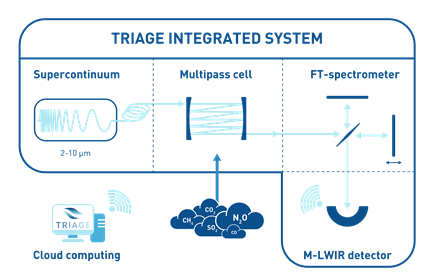Overview of TRIAGE
TRIAGE aims to provide smart photonic sensing for environmental air pollution monitoring, by prototyping a portable, high-performance, sensing system, based on cutting-edge photonic technology for pervasive air quality sensing. By accessing the infrared atmospheric window between 2-10 µm, high specificity and sensitivity for molecular gases is achieved as each molecule has its characteristic infrared absorption spectrum in this ‘fingerprint’ region. As such, TRIAGE can detect minute traces of molecules in complex gas mixtures and will provide real time information and analysis.
This presentation gives an overview of the project background and objectives.
Project update video
Here is a short video to update on the progress made during the project, and the plans for the demonstration at the project conclusion. Thanks to all the speakers, and to Sanghoon Chin (CSEM) for the camerawork and Daniel Napier (Vivid) for the editing.
Project intro video
Below is a quick video intro to TRIAGE recorded during lock-down! Apologies for the background noise! Thanks to Ole Bang (DTU) and Laurent Balet (CSEM) for the interviews, and Jason Buckley (Vivid) for the editing!
TRIAGE technology elements
The general TRIAGE approach is the following: a broad spectrum generated by a specifically designed supercontinuum (SC) laser (covering the wavelength region between 2-10 µm) will propagate through an environmental air sample with an optical path length of many metres in either a compact multi-pass cell or through free space e.g. between buildings using a retroreflector. In both cases, a compact Fourier Transform Spectrometer (FTS) will be used in combination with an IR detector for hyperspectral analysis. The measured hyperspectral data will then be conveyed wirelessly to a nearby access point for analysis in “the cloud”, using sophisticated machine learning algorithms and neural networks.

Simplified block-diagram of the overall TRIAGE sensor system
In TRIAGE, several technologies will be developed, integrated and demonstrated:
- Hardware
- 2-10 micron supercontinuum sources by NORBLIS and DTU
- Rugged low noise 2 µm pump laser by NKT Photonics
- High-performance multi-pass absorption cell by Senseair
- Senseair has prepared a video showing how the MPC is assembled
- Infrared detector modules by VIGO System
- FT spectrometer by Radboud University
- The system will be integrated by CSEM
- Data analysis
- Reference database by Radboud University
- Analysis and deep learning algorithms by CSEM
- Check out this online demo showing the estimate of gas mixture composition from the spectra
- Demonstration
- Linköping University will be responsible for the tests of functionality and long-term demonstration of the TRIAGE system.
- Demo activities will be conducted in real world settings (urban environments and on transport networks)
- Several key players from the TRIAGE-NET will be involved, including national agencies relating to environmental air monitoring and instrumentation manufacturers
- More info soon!